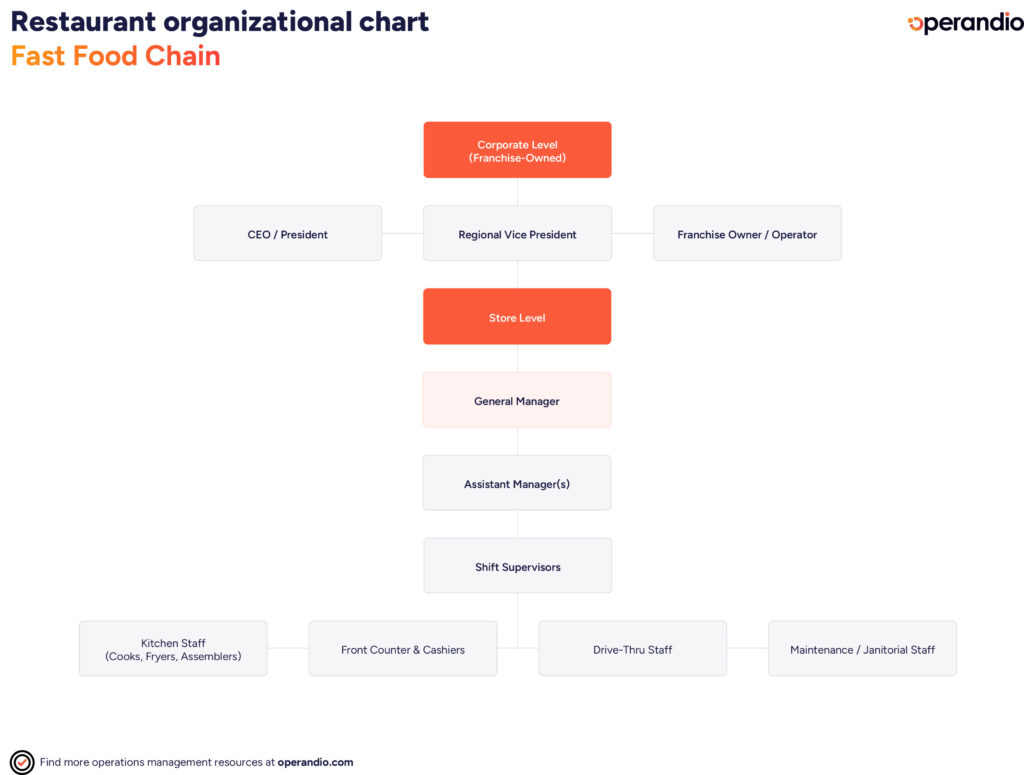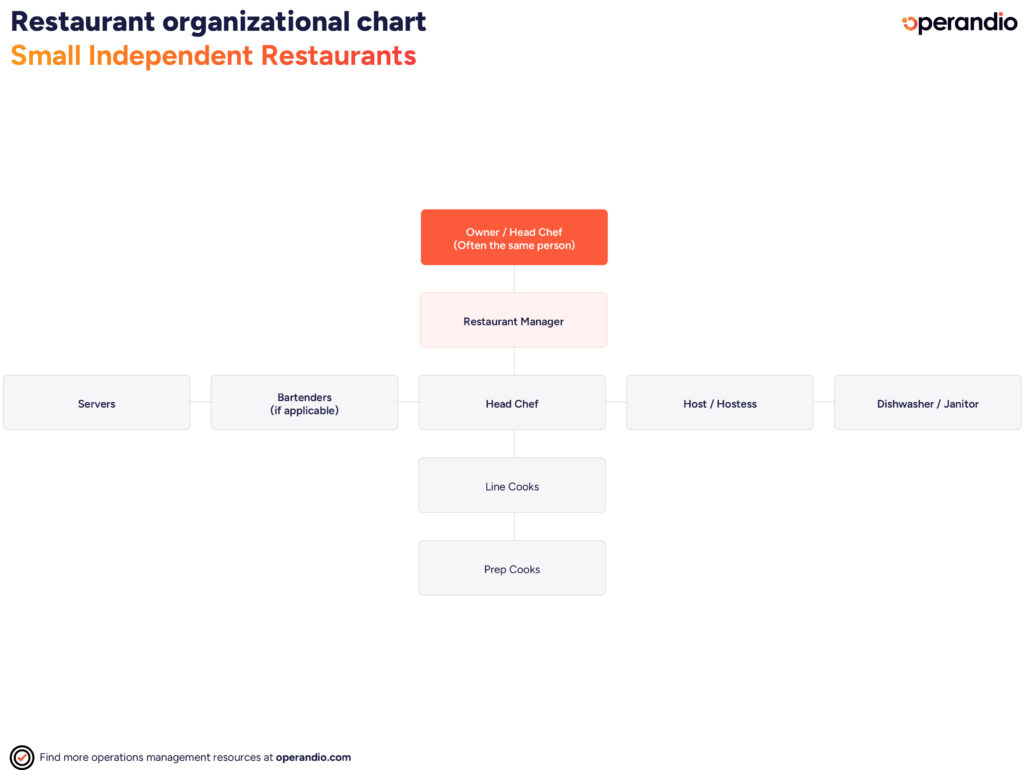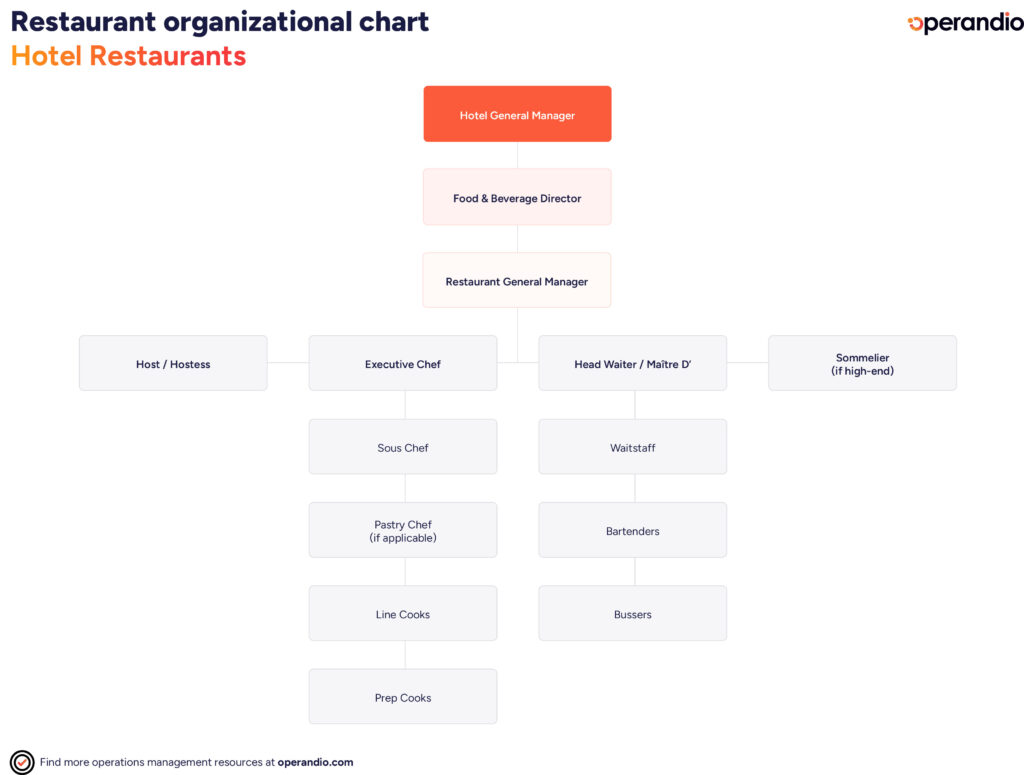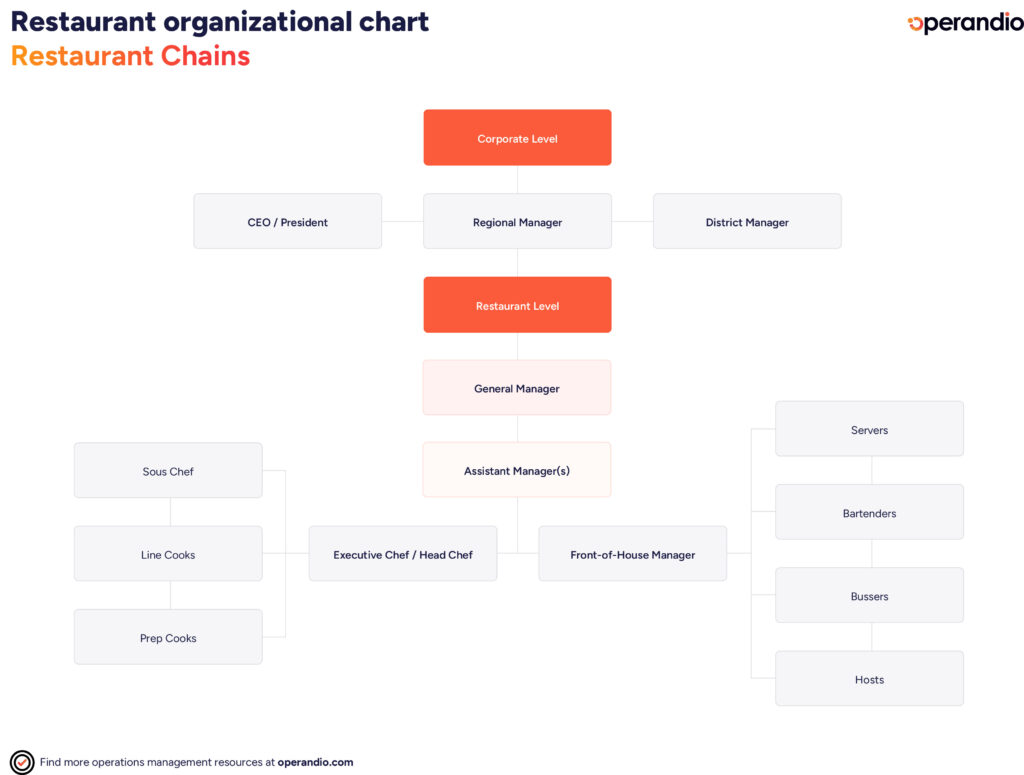2025 Restaurant Organizational Chart & Guidance
Key takeaways
- A restaurant organizational chart defines the chain of command, outlining who’s responsible for what across front-of-house and back-of-house operations.
- The hierarchy varies by restaurant type — from streamlined roles in fast food chains to layered structures in hotel or franchise restaurants.
- An effective org chart boosts efficiency, accountability, and communication across your team.
- With Operandio, you can easily map your hierarchy, assign roles, and set custom user access levels for managers, chefs, and staff.
Running a restaurant is already demanding — but when roles aren’t clearly defined, things get chaotic fast.
Who’s managing shift schedules? Who’s keeping an eye on kitchen prep? And who’s checking in with staff during the dinner rush?
That’s where a restaurant organizational chart makes all the difference.
When your team knows who’s doing what — and why — everything runs more smoothly. A well-defined structure removes guesswork, reduces overlap, and helps everyone focus on the job at hand.
In this guide, we’ll break down what a restaurant organizational chart looks like, how it differs by restaurant type, and how to build one that fits your operation. We’ll also show you how Operandio can simplify the process, helping you assign roles, collaborate, and set user access levels that match your team’s responsibilities.
Clear roles, less stress, smoother shifts — let’s break it down.
Understanding restaurant hierarchy & restaurant chain of command
Every smooth-running restaurant has one thing in common: a clear chain of command.
A restaurant hierarchy defines who reports to whom, what each role is responsible for, and how communication flows across the team. Without it, tasks get missed, accountability gets fuzzy, and service quality suffers — all of which can impact overall restaurant efficiency.
- At the top, you’ll typically find the owner, general manager, or executive chef — the people steering the business or kitchen.
- Beneath them are key department leads like kitchen managers, floor supervisors, and bar managers, who oversee day-to-day execution and help enforce restaurant policies.
- Then come frontline team members like servers, hosts, line cooks, and dishwashers — each playing a crucial part in delivering a great customer experience.
In larger operations, the structure can get more complex with layers of assistant managers, regional supervisors, and corporate oversight. Tools like a digital manager log can help keep communication flowing across all levels. But even in smaller restaurants, having defined roles and responsibilities helps staff know exactly where they fit — and who to turn to for support.
The goal? Build a system where your team isn’t just working hard — they’re working together and upholding high restaurant standards.
Types Of Restaurant Organizational Hierarchies Based On The Restaurant Type
Not all restaurants are structured the same way. Nor should they be. Your hierarchy depends heavily on your restaurant’s size, service model, and staffing needs. Here’s how different setups typically look:
Fast food chain

In fast food chains, speed and consistency are the priorities. That’s why the restaurant hierarchy is simple and streamlined.
- Store manager sits at the top, responsible for operations, staffing, and performance.
- Shift supervisors or assistant managers handle daily tasks and customer issues.
- Crew members fill roles like cashiers, cooks, and food prep staff — often cross-trained for flexibility.
- Many fast food chains also have area managers who oversee multiple stores in a region.
This structure keeps decisions quick and responsibilities clear.
Small independent restaurants

Smaller operations often have tighter teams — and staff wear multiple hats.
- The owner may double as the general manager, handling everything from hiring to budgeting.
- A head chef or kitchen manager leads back-of-house, while a front-of-house manager oversees service.
- Servers, bartenders, and line cooks round out the team.
These restaurants rely heavily on communication and teamwork, making a clear (but flexible) structure essential.
Hotel restaurants

Hotel restaurants operate within a broader hospitality system, which adds complexity.
- The restaurant manager reports to the hotel’s F&B director.
- Executive chefs and sous chefs manage the kitchen.
- Hosts, servers, and bartenders are often cross-trained to work in various hotel dining outlets.
- Larger hotels may include banquet coordinators or room service teams under the same umbrella.
Coordination across departments is key, and hierarchy helps avoid confusion in a shared space.
Restaurant chains (non-fast food)

Casual dining chains or upscale franchises tend to follow a multi-layered structure to maintain consistency across locations.
- Each location has a general manager, supported by assistant managers for FOH and BOH.
- Kitchen staff, servers, and cleaning crews report into their respective leads.
- Above the store level, regional managers and corporate teams provide oversight, training, and compliance checks.
The focus here is on standardization, so roles and reporting lines are clearly defined.
Restaurant organizational chart
An organizational chart gives you a clear snapshot of how restaurant management structure — from top-level leadership to front-line staff. It helps everyone understand their role, who they report to, and how responsibilities flow across departments.
We’ve included a handy downloadable org chart templates above, based on the type of restaurant you are running, to help you get started.
It outlines the key roles found in most restaurant operations — from general managers and head chefs to servers and kitchen staff.
Operandio gives you the tools to bring this structure to life — letting you assign roles, organize responsibilities, and update team access in real time, so everyone stays aligned and accountable.
How to create your own restaurant organizational chart
Every restaurant runs a little differently, and your org chart should reflect that. Building your own structure allows you to match roles and responsibilities to how your team works.
Here’s how to get started:
- Define key roles and responsibilities
List out every function your restaurant needs — from general management to dishwashing. Be specific about who does what, and where responsibilities begin and end. - Structure the hierarchy based on your size
Smaller venues might only need a few layers of management, while larger teams often benefit from more formal reporting lines and role separation. - Include both front-of-house and back-of-house positions
Your org chart should show how FOH and BOH teams are connected — not siloed. - Use digital tools for easy updates and team collaboration
Operandio lets you map out your structure, assign roles, and adjust responsibilities in real time as your team grows or changes.
- Set user access levels by role
With Operandio, you can control who sees what. Give managers, chefs, and staff access to exactly what they need — keeping things secure, streamlined, and role-appropriate. - Customize your chart to fit how you operate
Whether you run a casual diner or a multi-site operation, your org chart should match the way your team works — not the other way around.
A clear, flexible structure is more than just helpful — it’s the foundation for running a consistent, scalable, and confident operation.
Operandio: The Restaurant Software You Need
Managing a restaurant is already a full-time job — your software should make it easier, not harder. Operandio gives hospitality teams the structure, clarity, and tools they need to run a more efficient, compliant, and consistent operation.
Here’s what you can do with Operandio’s restaurant management software:
- Organize and update your team structure in real time, so everyone knows exactly where they fit and what they’re responsible for.
- Control user access by role, keeping the right tools in the right hands — from managers to front-line staff
- Simplify task management, training, and audits with one easy-to-use platform
- Support kitchen management with tools to keep your BOH team organized and on track
- Improve shelf life management with digital logs, checklists, and reminders that reduce waste
- Get powerful insights that help owners make smarter decisions
Whether you’re running a single site or managing multiple venues, Operandio helps you bring structure to the chaos and clarity to your team.
Book your free demo today and see how Operandio can help your restaurant run better — every shift, every day.


